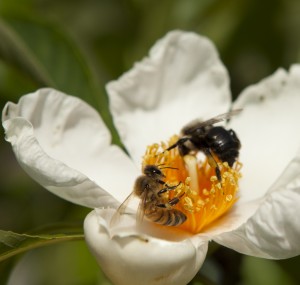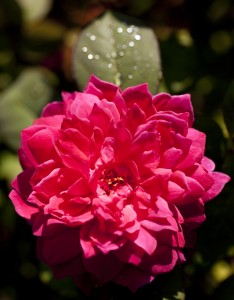Morning Eye Candy: Still Blooming
Posted in Around the Garden, Photography on September 1 2012, by Matt Newman
Would it be merry Saturday, or happy Saturday? Either way, the hibiscus are still blooming.
Photo by Ivo M. Vermeulen

Inside The New York Botanical Garden
Posted in Around the Garden, Photography on September 1 2012, by Matt Newman
Would it be merry Saturday, or happy Saturday? Either way, the hibiscus are still blooming.
Photo by Ivo M. Vermeulen
Posted in Around the Garden, Photography on August 31 2012, by Matt Newman
Seeing pine cones in the trees never fails to set me off thinking about winter preparations. New boots, mending buttons on an old jacket, the mortifying possibility that I’ll have to be out on the sidewalk, smacking at ice with a shovel in the near future. But there are good things swept along with the cold, like our most beloved holiday exhibition. Stay tuned for more on that as we edge closer to the season.
In the meantime, let’s savor these last days of summer, shall we?
Photo by Ivo M. Vermeulen
Posted in Around the Garden, Photography on August 30 2012, by Matt Newman
Seeing an Echinops globe by its lonesome might trick you into thinking you’re looking at a smallish allium (onions, garlic) flower, but don’t be fooled. They’re actually a type of thistle (and a good way to break up the riot of orange we’ve had dominating the blog feed for the last few days).
Echinops bannaticus ‘Blue Globe’ — Photo by Ivo M. Vermeulen
Posted in Around the Garden, Photography on August 29 2012, by Matt Newman
Orange to the point that it almost seems to siphon off the color from the foliage around it. Wishing you a happy Wednesday from the Seasonal Border.
Photo by Ivo M. Vermeulen
Posted in Around the Garden, Photography on August 27 2012, by Matt Newman
If you happen to stop by the Ruth Rea Howell Family Garden for “Pollinator Pals,” running now through October 5, you might be lucky to catch a few fluttering monarchs as they make their annual migration to Mexico. Despite what experience tells us, this flight is somewhat more challenging than eight hours spent in coach.
Photo by Ivo M. Vermeulen
Posted in Around the Garden, Photography on August 26 2012, by Matt Newman
Just checking in with some popular bombshells from the Perennial Garden. Got any plans to close out the weekend?
Photo by Ivo M. Vermeulen
Posted in Around the Garden, Photography on August 25 2012, by Matt Newman
Wishing everyone a happy Saturday from the Ruth Rea Howell Family Garden! If being knee-deep in vegetables is your style, there’s no place like it.
Photo by Ivo M. Vermeulen
Posted in Around the Garden on August 24 2012, by Matt Newman
 Would I say there’s a busy atmosphere about the Ruth Rea Howell Family Garden this weekend? Definitely. But would I say there’s a…buzzy atmosphere? Seeing as I’m absolutely the kind of guy to kick off a wave of pained groans by dropping such a boulder of a pun, I’m going to go ahead and affirm that one. As of this week, New York’s favorite vegetable garden is looking beyond the tomatoes and cucumbers to the pollinators that make them possible, and that includes our lively honey bees!
Would I say there’s a busy atmosphere about the Ruth Rea Howell Family Garden this weekend? Definitely. But would I say there’s a…buzzy atmosphere? Seeing as I’m absolutely the kind of guy to kick off a wave of pained groans by dropping such a boulder of a pun, I’m going to go ahead and affirm that one. As of this week, New York’s favorite vegetable garden is looking beyond the tomatoes and cucumbers to the pollinators that make them possible, and that includes our lively honey bees!
Overlooking the NYBG‘s one-acre vegetable plot is a pair of active beehives that you can see and read about in one of our earlier picture galleries, but if you really want to grasp just what it is that has New York City’s rooftop gardeners going mad for apiculture, you and your children should come and visit. Through “Pollinator Pals,” we’re opening up this integral piece of the agricultural puzzle with fun activities for kids, as well as the opportunity to see first-hand how a beehive works and even sample a few different types of honey. The experience isn’t limited to what you get in a bear-shaped squeeze bottle at the supermarket–what’s growing near the hive can noticeably influence the nuanced flavors of the honey the bees produce.
Posted in Around the Garden, Photography on August 24 2012, by Matt Newman
Why do they call it an anemone, anyway? At a glance, the flower doesn’t seem to have much in common with the seagoing variety. But according to the Oxford English Dictionary, the word comes from the Greek for “daughter of the wind.” Most sea anemones seem to fit that description, waving as they do in the ocean currents, so I suppose a flower bobbing in the breeze is close enough.
Photo by Ivo M. Vermeulen
Posted in What's Beautiful Now on August 23 2012, by Matt Newman
 Stick your head out the window. You don’t have to be full-on family dog weird about it–just poke it out there and see what the weather’s like. Is it a warm day, no sidewalks buried in snow drifts or ice hazard traffic advisories? Then odds are good that the Peggy Rockefeller Rose Garden should be somewhere in the top three lines of your list of destinations. There are over 4,000 rose specimens in this collection alone, and while spring is the season when visitors are most often scrambling to get a peek (understandably, as roses are like smelling salts after the listless gloom of winter), many people don’t realize that there’s a confetti of colorful rose cultivars blooming at the NYBG for a solid six months out of the year.
Stick your head out the window. You don’t have to be full-on family dog weird about it–just poke it out there and see what the weather’s like. Is it a warm day, no sidewalks buried in snow drifts or ice hazard traffic advisories? Then odds are good that the Peggy Rockefeller Rose Garden should be somewhere in the top three lines of your list of destinations. There are over 4,000 rose specimens in this collection alone, and while spring is the season when visitors are most often scrambling to get a peek (understandably, as roses are like smelling salts after the listless gloom of winter), many people don’t realize that there’s a confetti of colorful rose cultivars blooming at the NYBG for a solid six months out of the year.
Skip over to the Rose Garden right now (while the weather is almost confusingly decent, hence the skipping; I’m talking sit-outside-for-lunch pleasant) and you’ll find the stage set with a show of shrub roses in pinks, whites, and reds. Floribunda, grandiflora, hybrid tea–they’re all there, petaled like petticoats and parasols.